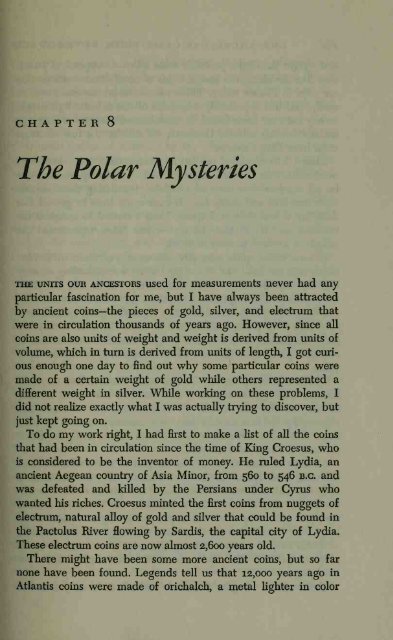You also want an ePaper? Increase the reach of your titles
YUMPU automatically turns print PDFs into web optimized ePapers that Google loves.
CHAPTER 8<br />
The Polar Mysteries<br />
THE UNITS OUR ANCESTORS used for measurements never had any<br />
particular fascination for me, but I have always been attracted<br />
by ancient coins—the pieces of gold, silver, and electrum that<br />
were in circulation thousands of years ago. However, since all<br />
coins are also units of weight and weight is derived from units of<br />
volume, which in turn is derived from units of length, I got curious<br />
enough one day to find out why some particular coins were<br />
made of a certain weight of gold while others represented a<br />
different weight in silver. While working on these problems, I<br />
did not realize exactly what I was actually trying to discover, but<br />
just kept going on.<br />
To do my work right, I had first to make a list of all the coins<br />
that had been in circulation since the time of King Croesus, who<br />
is considered to be the inventor of money. He ruled Lydia, an<br />
ancient Aegean country of Asia Minor, from 560 to 546 b.c. and<br />
was defeated and killed by the Persians under Cyrus who<br />
wanted his riches. Croesus minted the first coins from nuggets of<br />
electrum, natural alloy of gold and silver that could be foimd in<br />
the Pactolus River flowing by Sardis, the capital city of Lydia.<br />
These electnmi coins are now almost 2,600 years old.<br />
There might have been some more ancient coins, but so far<br />
none have been found. Legends tell us that 12,000 years ago in<br />
Atlantis coins were made of orichalch, a metal Hghter in color

















